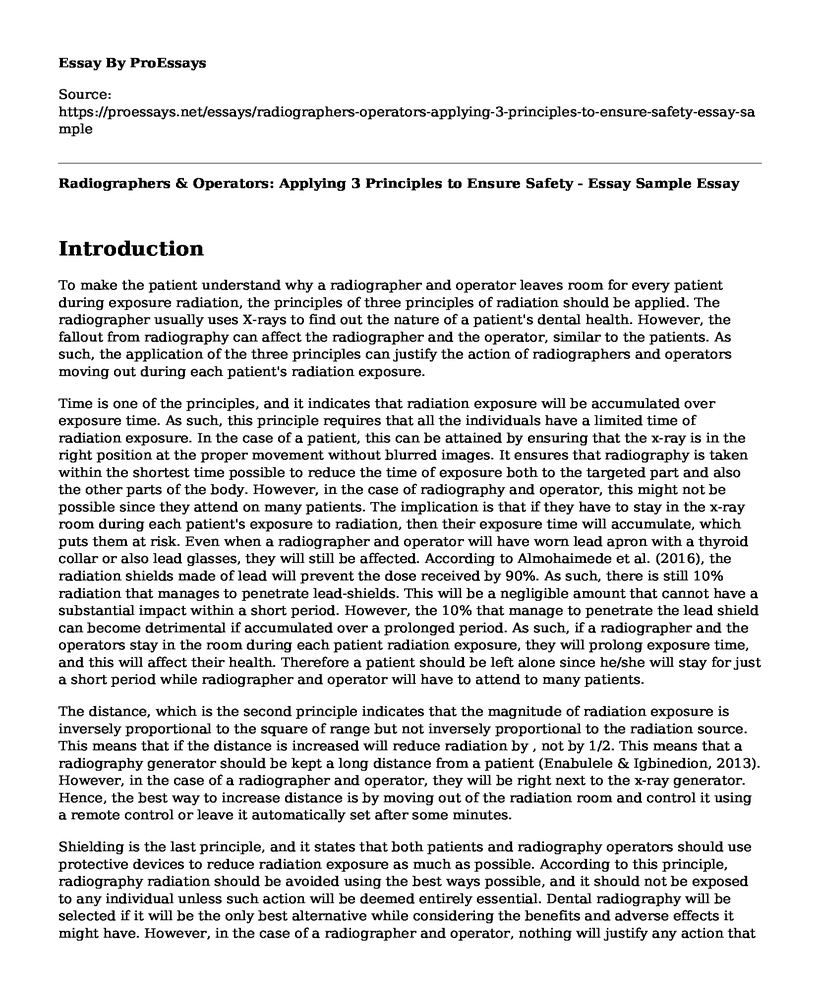Introduction
To make the patient understand why a radiographer and operator leaves room for every patient during exposure radiation, the principles of three principles of radiation should be applied. The radiographer usually uses X-rays to find out the nature of a patient's dental health. However, the fallout from radiography can affect the radiographer and the operator, similar to the patients. As such, the application of the three principles can justify the action of radiographers and operators moving out during each patient's radiation exposure.
Time is one of the principles, and it indicates that radiation exposure will be accumulated over exposure time. As such, this principle requires that all the individuals have a limited time of radiation exposure. In the case of a patient, this can be attained by ensuring that the x-ray is in the right position at the proper movement without blurred images. It ensures that radiography is taken within the shortest time possible to reduce the time of exposure both to the targeted part and also the other parts of the body. However, in the case of radiography and operator, this might not be possible since they attend on many patients. The implication is that if they have to stay in the x-ray room during each patient's exposure to radiation, then their exposure time will accumulate, which puts them at risk. Even when a radiographer and operator will have worn lead apron with a thyroid collar or also lead glasses, they will still be affected. According to Almohaimede et al. (2016), the radiation shields made of lead will prevent the dose received by 90%. As such, there is still 10% radiation that manages to penetrate lead-shields. This will be a negligible amount that cannot have a substantial impact within a short period. However, the 10% that manage to penetrate the lead shield can become detrimental if accumulated over a prolonged period. As such, if a radiographer and the operators stay in the room during each patient radiation exposure, they will prolong exposure time, and this will affect their health. Therefore a patient should be left alone since he/she will stay for just a short period while radiographer and operator will have to attend to many patients.
The distance, which is the second principle indicates that the magnitude of radiation exposure is inversely proportional to the square of range but not inversely proportional to the radiation source. This means that if the distance is increased will reduce radiation by , not by 1/2. This means that a radiography generator should be kept a long distance from a patient (Enabulele & Igbinedion, 2013). However, in the case of a radiographer and operator, they will be right next to the x-ray generator. Hence, the best way to increase distance is by moving out of the radiation room and control it using a remote control or leave it automatically set after some minutes.
Shielding is the last principle, and it states that both patients and radiography operators should use protective devices to reduce radiation exposure as much as possible. According to this principle, radiography radiation should be avoided using the best ways possible, and it should not be exposed to any individual unless such action will be deemed entirely essential. Dental radiography will be selected if it will be the only best alternative while considering the benefits and adverse effects it might have. However, in the case of a radiographer and operator, nothing will justify any action that exposes them to radiation (Crane & Abbott, 2016). This provides a rationale for a photographer and operator moving out during radiation exposure.
References
Almohaimede, A. A., Bendahmash, M. W., Dhafr, F. M., Awwad, A. F., & Al-Madi, E. M. (2020). Knowledge, Attitude, and Practice (KAP) of Radiographic Protection by Dental Undergraduate and Endodontic Postgraduate Students, General Practitioners, and Endodontists. International Journal of Dentistry, 2020.
Crane, G. D., & Abbott, P. V. (2016). Radiation shielding in dentistry: an update. Australian dental journal, 61(3), 277-281.
Enabulele, J. E., & Igbinedion, B. O. (2013). An assessment of Dental Students' knowledge of radiation protection and practice. Journal of Education and Ethics in Dentistry, 3(2), 54.
Lilienthal, B. (2018). Minimizing radiation exposure in dental radiology: 1. Hazards and precautions. Australian dental journal, 19(5), 308-312.
Memon, A., Godward, S., Williams, D., Siddique, I., & Al-Saleh, K. (2016). Dental x-rays and the risk of thyroid cancer: a case-control study. Acta Oncologica, 49(4), 447-453.
Monsour, P. A., Kruger, B. J., Barnes, A., & Sainsbury, A. (2018). Measures are taken to reduce Xray exposure of the patient, operator, and staff. Australian dental journal, 33(3), 181-192.
White, S. C., & Mallya, S. M. (2019). Update on the biological effects of ionizing radiation, relative dose factors, and radiation hygiene. Australian dental journal, 57, 2-8.
Cite this page
Radiographers & Operators: Applying 3 Principles to Ensure Safety - Essay Sample. (2023, Jun 07). Retrieved from https://proessays.net/essays/radiographers-operators-applying-3-principles-to-ensure-safety-essay-sample
If you are the original author of this essay and no longer wish to have it published on the ProEssays website, please click below to request its removal:
- Essay on the Book Deaf Like Me
- Essay Sample on Spiritual Issues Surrounding Disasters
- Essay Sample on Role of Nurses in Medical Practises
- Essay Sample on DayTwo: AI-Based Gut Microbiome-Based Personalised Nutrition
- Essay Example on Abortion Debate: Pro-Choice vs Pro-Life
- Thesis Sample on Preventing CLABSIs: The Ideology Behind Psychiatric Nursing
- Managing Interruptions in Medical Administration: A Critical Analysis and Practical Solutions - Paper Sample







